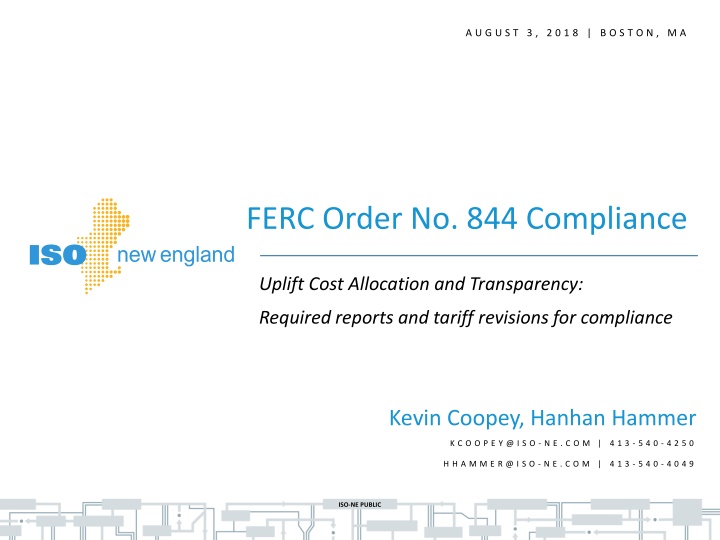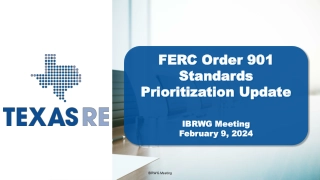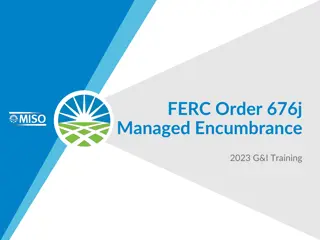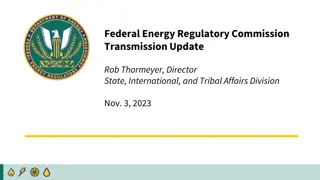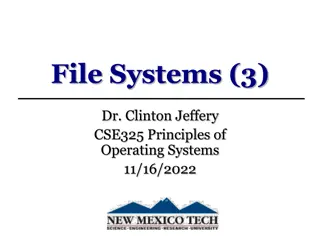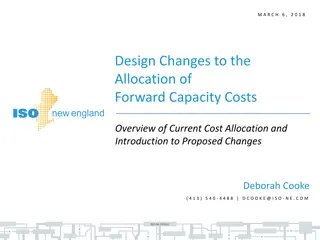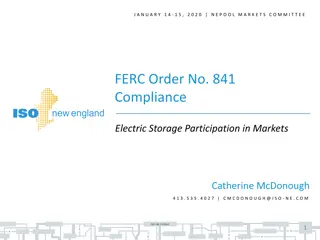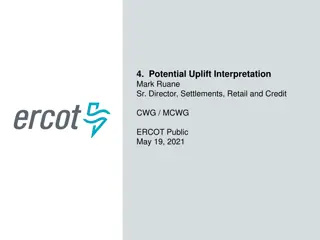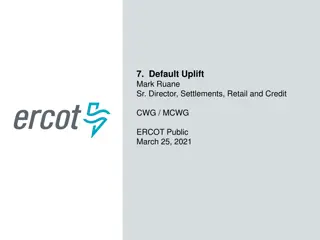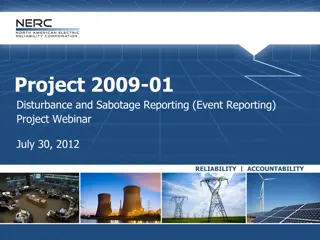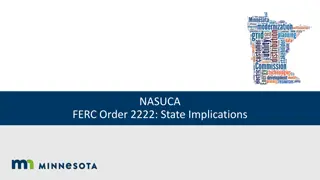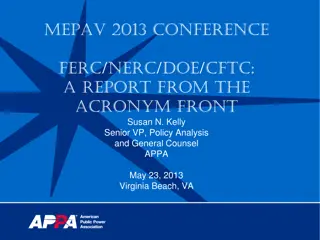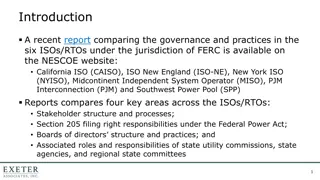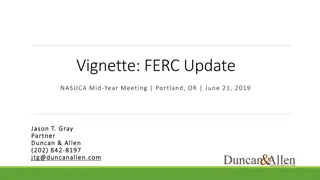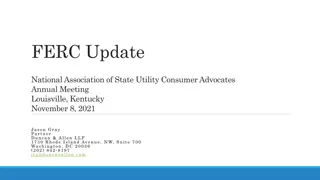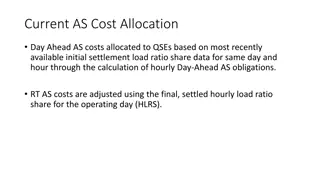FERC Order 844 Compliance: Uplift Cost Allocation and Transparency
FERC Order 844, issued in April 2018, mandates reporting on uplift payments and unit commitments, along with revising tariff language for compliance. ISO-NE is proposing new reports and tariff revisions to adhere to the Order, enhancing transparency in operational practices. The Order aims to improve transparency by increasing reporting on uplift payments and operator-initiated commitments. Unlike the NOPR, Order 844 does not provide specific directives on uplift cost allocation but emphasizes reporting requirements. The ISO is working on publishing Real-Time commitment and uplift data through designated reports by improving transparency in the energy markets.
Download Presentation

Please find below an Image/Link to download the presentation.
The content on the website is provided AS IS for your information and personal use only. It may not be sold, licensed, or shared on other websites without obtaining consent from the author.If you encounter any issues during the download, it is possible that the publisher has removed the file from their server.
You are allowed to download the files provided on this website for personal or commercial use, subject to the condition that they are used lawfully. All files are the property of their respective owners.
The content on the website is provided AS IS for your information and personal use only. It may not be sold, licensed, or shared on other websites without obtaining consent from the author.
E N D
Presentation Transcript
A U G U S T 3 , 2 0 1 8 | B O S T O N , M A FERC Order No. 844 Compliance Uplift Cost Allocation and Transparency: Required reports and tariff revisions for compliance Kevin Coopey, Hanhan Hammer K C O O P E Y @ I S O - N E . C O M | 4 1 3 - 5 4 0 - 4 2 5 0 H H A M M E R @ I S O - N E . C O M | 4 1 3 - 5 4 0 - 4 0 4 9 ISO-NE PUBLIC
WMPP ID: 128 FERC Order 844 Compliance: Summary Proposed Effective Date: January 1, 2019 Order 844, issued April 19, 2018, requires three new monthly reports concerning uplift payments and unit commitments Order 844 also requires each ISO to document in the tariff the current implementation for transmission constraint penalty factors The ISO is proposing new reports and tariff language to comply with the Order This is the first meeting with the NEPOOL Markets Committee to discuss the ISO s proposal in response to Order 844 ISO-NE PUBLIC 2
ORDER 844: UPLIFT COST ALLOCATION AND TRANSPARENCY Uplift Payments and Operator Initiated Commitment Reporting ISO-NE PUBLIC ISO-NE PUBLIC 3
Order 844: Uplift Cost Allocation and Transparency Issued April 19, 2018 Order 844 follows the January 2017 NOPR Uplift Cost Allocation and Transparency in Markets Operated by Regional Transmission Organizations and Independent System Operators. Order 844 will improve transparency practices though increased reporting of uplift payments and operator initiated commitments Unlike the NOPR, Order 844 contains no directives on uplift cost allocation The ISO is developing reports in response to FERC Order 844 requirements to publish Real-Time commitment and uplift data in three separate reports Zonal Uplift Report Resource-Specific Uplift Report Operator Initiated Commitment Report ISO-NE PUBLIC 4
Uplift Payment Reporting Zonal Uplift* Report Order 844 requires the ISO to report, on a monthly basis, total uplift payments for each transmission zone**, broken out by day and uplift category Resource-Specific Uplift Report Order 844 requires the ISO to report, on a monthly basis, total uplift payments for each resource * Uplift in the context of New England refers to Net Commitment Period Compensation (NCPC) ** Transmission zone in the context of New England refers to Load Zone ISO-NE PUBLIC 5
Zonal Uplift Report Must be posted monthly within 20 calendar days of the end of the month Must be posted in a machine-readable format on a publicly accessible portion of the ISO s website, and not password protected The ISO currently publishes Net Commitment Period Compensation (NCPC) data in comma separate values (CSV) format on ISO website (via ISO Express) Currently these reports do not specify the transmission zone of the resources receiving NCPC payments, which Order 844 requires ISO-NE PUBLIC 6
Zonal Uplift Report Reporting Categories The existing NCPC reports on ISO Express group uplift into eight categories: External Location Economic Generator Performance Auditing Economic High Voltage VAR Non-High Voltage VAR LSCPR Dispatch Lost Opportunity Cost Rapid-Response-Pricing Opportunity Cost Special Constraint Resource NCPC* needs to be added to the NCPC categories available for download on the ISO s website * NCPC incurred by resources committed to support the distribution system ISO-NE PUBLIC 7
Resource-Specific Uplift Report Must be posted monthly within 90 calendar days of the end of the month Must be posted in a machine-readable format on a publicly accessible portion of the ISO s website, and not password protected The ISO currently does not publish any resource-specific NCPC data Order 844 discusses potential for the release of confidential information and addresses commenters concerns in two ways The Resource-Specific Uplift Report will be reported with a longer lag time than the Zonal Uplift Report The Resource-Specific Uplift Report will be a monthly aggregation of NCPC payments ISO-NE PUBLIC 8
Operator Initiated Commitment Reporting Order 844 requires the ISO to report, on a monthly basis, for each operator-initiated commitment: Size of the commitment Transmission zone (to match the Zonal Uplift Report) Commitment reason Commitment start time Must be posted monthly within 30 calendar days of the end of the month Must be posted in a machine-readable format on a publicly accessible portion of the ISO s website, and not password protected ISO-NE PUBLIC 9
Operator Initiated Commitment Report Order 844 clarifies what constitutes an Operator Initiated Commitment (paragraph 100): In order to be more precise, we therefore modify the definition of an operator-initiated commitment to be a commitment after the day-ahead market, whether manual or automated, for a reason other than minimizing the total production costs of serving load The ISO will publish all commitments occurring after the Day Ahead Market for all commitment reasons; except commitments that are made to minimize the total production cost of serving load The ISO will publish commitments made through the Reserve Adequacy Analysis (RAA) process The ISO will not publish the (fast-start unit) commitments made to minimize total production costs from the intra-day look-ahead and RT- dispatch optimization processes ISO-NE PUBLIC 10
Conclusion: The three reports required by Order 844 will be published on the ISO website Zonal Uplift Report Reported monthly, 20 days after the month, with daily NCPC dollars by load zone, uplift category Resource-Specific Uplift Report Reported monthly, 90 days after the month, with total monthly NCPC dollars by resource Operator Initiated Commitment Report Reported monthly, 30 days after the month, each Operator Initiated Commitment with the size, transmission zone, commitment reason, and commitment start time for each commitment All reports will be publically available on the ISO website in machine-readable format ISO-NE PUBLIC 11
Summary of Proposed Tariff Changes Tariff Section Tariff Change Reason for Change New language for the Zonal NCPC Report Order 844 Compliance III.F.4.1. New language for the Resource- Specific NCPC Report Order 844 Compliance III.F.4.2. New language for the Operator- Initiated Commitment Report Order 844 Compliance III.F.4.3. ISO-NE PUBLIC 12
ORDER 844: TRANSMISSION CONSTRAINT PENALTY FACTORS (TCPF) ISO s current practice and tariff language for compliance ISO-NE PUBLIC ISO-NE PUBLIC 13
Order 844 requirements on TCPF Order 844 requires the ISO to include in the tariff any transmission constraint penalty factors used in its market software circumstances under which those factors can set locational marginal prices any process by which they can be temporarily changed ISO proposes adding to the tariff the required information consistent with its current software and process ISO-NE PUBLIC 14
Context: TCPFs and implementations TCPF basics Two TCPF implementation approaches Economic approach (referenced in the Order) Physical approach (current ISO implementation) Compliance tariff changes ISO-NE PUBLIC 15
TCPF is a parameter in the dispatch software optimization process Dispatch software uses a linear optimization process to maximize social surplus, subjecting to all power system constraints, including transmission constraints In the dispatch solution, a transmission constraint is Satisfied, when projected power flow <= constraint limit Violated, when projected power flow > constraint limit TCPF determines under what circumstances a transmission constraint may be violated in the dispatch solution ISO-NE PUBLIC 16
Two Approaches to TCPF Implementation Depending on the TCPF implementation, projected power flow could exceed the constraint limit in the dispatch solution under two different conditions: No units can be dispatched economically to further reduce the flow, or No units can be dispatched physically to further reduce the flow If a transmission constraint violates under the first condition, an economic approach to TCPF is implemented Order 844 describes an economic approach If a transmission constraint violates under the second condition, a physical approach to TCPF is implemented ISO uses a physical approach ISO-NE PUBLIC 17
Economic Approach - as described in the Order In the economic approach, the dispatch solution will violate the constraint if the marginal cost to reduce flow (referred as re-dispatch cost in the Order) is greater than the TCPF TCPF is set at a value (in $/MWh) that in principle reflects the reliability risk from violating the constraint For example, the TCPF of a 345kV transmission constraint may be higher than a 115kV constraint Processes to temporarily change TCPFs could be necessary to reflect higher levels of reliability risk from: Violating the constraint under more stressed operating conditions, or More severe violations of the constraint limit, or Longer duration violations of the constraint limit ISO-NE PUBLIC 18
Economic Approach - continued Order states TCPF represent the maximum re-dispatch price that the system will pay before allowing flows to exceed a given transmission element s limit Under the economic approach, if a violation occurs the TCPF sets the shadow price of the constraint and is an input to the LMP calculation TCPF = shadow price (shadow price x locational shift factor) is included in the Congestion Component of the LMP calculation This is somewhat similar to how real-time Reserve Constraint Penalty Factors work (excepting the shift factors and Congestion Component) ISO-NE PUBLIC 19
Physical Approach ISO Implementation In the physical approach, the dispatch solution will violate the constraint only when it has exhausted all dispatch options To ensure dispatch solution exhausts all options, the TCPF is set at a level higher than the most expensive dispatch option to satisfy each constraint No need for processes to temporarily change the TCPF If a violation does occur, the marginal resources dispatched to reduce the last MW of flow on the constrained element would set the shadow price of the constraint TCPF doesn t set the shadow price ISO-NE PUBLIC 20
Physical Approach continued In the physical approach, a transmission constraint violation alerts real-time operations that Dispatching currently available resources cannot prevent the projected power flow from exceeding the constraint limit Actions other than unit dispatch must be taken to avoid overloading the transmission elements Actions that operators may use to control transmission element loading include: special protection system use, weather sensitive rating use, topology changes including circuit switching or load swaps, external interface flow reductions, commitment and/or de-commitment of resources, OP-4 Actions, and OP-7 Actions ISO-NE PUBLIC 21
Economic Approach vs. Physical Approach Economic Approach TCPF is set among the available dispatch options Violation could occur when a feasible dispatch option exists, but the option s cost exceeds the TCPF TCPF sets the shadow price of the violated constraint Physical Approach TCPF is set above the most expensive dispatch option Violation occurs when no feasible dispatch option exists Most expensive dispatch option sets the shadow price of the violated constraint ISO-NE PUBLIC 22
Issues: Economic approach TCPF values would need to vary with violation duration in New England Economic approach requires TCPF to reflect reliability risk from violating the constraints In New England, the reliability risk from violating the constraints increases with the duration of the violation because line ratings provided by the Transmission Owners have a time component. For example, Normal ratings can be exceeded for 4 hours in winter or 12 hours in summer without causing reliability concerns Long term ratings can be exceeded for 15 minutes without causing reliability concerns Economic approach TCPF values for New England would increase as the duration of the violation approaches the end of the time allowed ISO-NE PUBLIC 23
Observation: Benefits of an economic approach for New England may be limited To dispatch using time-dependent TCPF values, the software needs to optimize the system across multiple intervals Current dispatch software only performs single interval look ahead To operate the transmission system when a feasible dispatch option exists but is not economic to use, operational procedures need to address what should happen next Current operational procedures only address what should happen next when no feasible dispatch option exists New England has a robust transmission infrastructure with relatively little congestion The benefits of implementing the alternative economic TCPF approach may be limited for New England ISO-NE PUBLIC 24
Order 844 requires the ISO to document its current TCPF practice ISO proposes to reflect its current TCPF implementation (physical approach) in the tariff in response to the three requirements of Order 844 Order Requirements ISO s Current Practice 1. TCPF values Transmission constraints include line constraints and interface constraints TCPF value for day-ahead interface constraints is $10,000/MWh. TCPF value for all other transmission constraints is $30,000/MWh 2. Circumstances under which TCPF values can set prices TCPF does not set the shadow price of a violated constraint and is not an input to LMP calculations 3. Process for temporarily changing the TCPF values TCPF values are not temporarily changed ISO-NE PUBLIC 25
Summary of Proposed Tariff Changes Tariff Section Tariff Changes Reason for Change Create a new defined term Transmission Constraint Penalty Factor Order 844 compliance I.2.2 Order 844 compliance III.1.7.5 Note the ISO s current TCPF practice ISO-NE PUBLIC 26
Conclusion ISO proposes adding the tariff language that reflects the current TCPF implementation to comply with Order 844 Tariff language will be effective on January 1, 2019 ISO-NE PUBLIC 27
Stakeholder Schedule Stakeholder Committee and Date Scheduled Project Milestone Markets Committee August 3, 2018 Discuss Proposal & Review Tariff Changes Markets Committee August 14-15, 2018 Vote Participants Committee August 24, 2018 Vote ISO-NE PUBLIC 28
Acronyms Used in this Presentation NCPC Net Commitment Period Compensation NOPR Notice of Proposed Rule Making RAA Reserve Adequacy Analysis TCPF Transmission Constraint Penalty Factor LMP Locational Marginal Price ISO-NE PUBLIC 30
